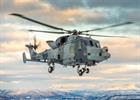COOL FOR CATS IN NORWAY
Cool for cats as Royal Marines new helicopter is tested for first time inNorway
The Royal Marines’ ‘flying eyes’ on the battlefield have come through their ‘baptism of ice’ in the Arctic wilds of northernNorway.
For the first time, the new Wildcats of the Commando Helicopter Force have tested their ability to fly – and fight – in the harshest climatic conditions on the planet.
Four Wildcats from 847 Naval Air Squadron have spent six weeks contending with temperatures down to 30 below zero, snow storms and high winds.
Each winter the Commando Helicopter Force takes some of its aircraft, air and ground crew to Bardufoss – roughly half way between Tromsø and Narvik, and a good 170 miles inside theArctic Circle.
The training – Exercise Clockwork – is intended to ensure sailors and Royal Marines on the force can survive in such an unforgiving environment (living in tents or snow holes, if necessary, clambering out of holes in the ice if it breaks) as well as maintain their helicopters and, in the case of the aircrew, fly them.
The latter saw the fliers run through the gamut of military operations from the basics of landing in snow – the down-draught from the rotor blades throws up a swirling wall of fine snow – to ferrying loads, scouting for the troops on the ground, a spot of shooting practice for the aircrewman with the machine-gun and using the Wildcat to direct Allied jets on to targets.
The Norwegian experience saw the Wildcats packed into the cavernous cargo holds of RAF C-17 transporters for the first time and demonstrated that the helicopters’ mottled grey paint scheme is a highly-effective camouflage in the snow.
“I’ve been toNorwaybefore but this is my first time flying here,” explained pilot Lt Alex Lovell-Smith. “The challenges are unique: the weather can change in an instant, so our captaincy and flying skills are always tested.
“I certainly feel that my aviation skills have improved in a way that onlyNorwaycan provide. Everyone on 847 agrees thatNorwayhas given us an excellent opportunity to bond as a squadron – and push the Wildcat to its limits in this new environment.”
When 847 arrived in northernNorway, they faced just three hours of daylight. By the time they left that had risen to nine, allowing for plenty of flying.
“The guys have pushed hard to learn the lessons and keep the aircraft on the line.
Serviceability has been good – that’s supported a high rate of flying and meant we successfully completed our training,” said air engineer technician PO John ‘Julie’ Andrews.
“For many of our more junior engineers, this has been their first time inNorwayand they are all relishing the chance to come back again.”
The squadron made use of the facilities at the Norwegian Air Force Base in Bardufoss, working side-by-side with NH-90 andBell412 helicopters, while the Brits showed off their helicopter to their hosts.
“We came toNorwaywith definite objectives – we’ve not just hit them, we’ve surpassed them,” said Commander Graeme Spence, 847’s Commanding Officer.
“Wildcat has met the challenge head-on, as have our people. Our flying rate has been high and we’ve achieved a lot more than just qualifying to operate in the Arctic environment.
“Norway’s always been a special place for the Commando Helicopter Force – and we’ve made the most of the opportunities to test ourselves and our aircraft.”
Now back at base in Somerset, the squadron is preparing for the large-scale Anglo-French amphibious exercise in the Bristol Channel and Irish Sea next month [APRIL], Griffin Strike, followed by desert warfare training in El Centro in southern California.




